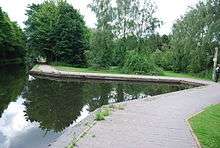Winding hole

A winding hole (/ˈwɪndɪŋ/) is a widened area of a canal (usually in the United Kingdom), used for turning a canal boat such as a narrowboat.
Etymology
| Look up winding in Wiktionary, the free dictionary. |
The word is commonly believed to derive from the practice of using the wind to assist with the turn.[1] It is notable that the German term for turning a vehicle is "wenden". Much UK canal terminology comes from spoken rather than written tradition and from bargees who did not read or write.[2] However, it is also possible that the word has a similar derivation to that of the windlass, which derives from the Old Norse "vinda" and "ás"—words currently used in Iceland—where the modern word for "windlass" is "vinda".[3]
History
Because the average width of a canal channel (about 30' to 40' feet) is less than the length of a full-size narrow boat (72') it is not usually possible to turn a boat in the canal. Winding holes are typically indentations in the off-side (non-towpath side) of the canal, allowing sufficient space to turn the boat.
Use
A winding hole consists of a "notch" in the canal bank. A turning boat inserts its bow into the notch and swings the stern round. In the days of horse-drawn boats, this was accomplished using bargepoles.[4][5][6]
See also
References
- ↑ Deuchar, Chris N. (1997). A boaters guide to boating. [S.l.]: C.N. Deuchar on behalf of the historic Narrow Boat Owners Club. p. 13. ISBN 0953151204.
- ↑ Stewart, Sheila (1994). Ramlin Rose: The Boatwoman's Story. Oxford, UK: Oxford Paperbacks. ISBN 9780192853028.
- ↑ Hilbertsson, ritstjóri, Sævar (2000). Ensk íslensk orðabók og íslensk-ensk orðabók (2000 [2.] útg. ed.). [Reykjavík]: Orðabókaútgáfan. ISBN 9979835206.
- ↑ Hankinson, John (1967). Canal Cruising. Ward Lock. pp. 62–64.
- ↑ Marsh, Bryan (1985). The Inland Navigator. Penguin. pp. 140–141. ISBN 0-14-046666-5.
- ↑ Yorke, Stan (2003). English Canals Explained. Countryside Books. p. 44. ISBN 1-85306-825-X.